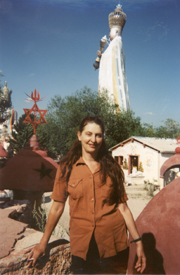
Susan Palmer, in front
of the Cosmoplanetary Messiah, erected in the French Alps by the Mandarom,
a Hindu-based cult. The statue, the most important of many erected by
the cult, has since been destroyed by the French government.
|
by Barbara Black
Susan Palmer is a scholarly expert on the Raëlians, the Quebec-based
new religion posited on extra-terrestrials and free love. She’s writing
a book about them for Rutgers University Press, and she is often consulted
by journalists.
This brings with it certain anxieties. Every misquote or mangled statistic
attributed to her in the press drives a wedge between the social scientist
and her subjects, with whom she has so far enjoyed a trusting and friendly
relationship.
Until recently, the Raëlians have tended to view any media attention,
however derisory, as good publicity, and in general, the Quebec press,
like Quebecers themselves, has been remarkably warm towards the movement.
Since the leader Raël, born as Claude Vorilhon, came to Quebec in
1992, the movement has flourished; Palmer puts its worldwide membership
at about 55,000, most of them in Quebec, French-speaking Europe and Japan.
It has elements that appeal to post-Quiet-Revolution Quebecers, notably
a scientific worldview and broad social and sexual tolerance. Adherents
in the general membership have lives much like the rest of us: they obey
the laws, hold down jobs, and have families. The fact that they believe
that humans were created by extraterrestrial superscientists seems hardly
to matter.
The Raëlians grabbed international headlines last March, when Raël
was asked to testify before a U.S. congressional subcommittee hearing
into human cloning.
In an article she wrote for Religion in the News, a U.S. magazine,
Palmer said it was “a day of triumph” for the 54-year-old founder,
who wore a white suit and a star-shaped pendant, his thinning hair done
up in a bun. He was accompanied by Dr. Brigitte Boisellier, director of
the Raëlians’ scientific arm, Clonaid, who assured the bemused
law-makers that she is well on the way to replicating a human being.
In the United States, the movement is now recognized for tax purposes
as a religion. Palmer says that last February she wrote a report to support
the Raëlians’ application for similar status in Canada. It had
previously been denied, on the grounds that Raëlians venerate the
extraterrestrials as material beings rather than gods.
Raël left France because of negative publicity. Palmer is sharply
critical of the strong anti-cult legislation that has been introduced
there and in Belgium. The Europeans, she says, have different flash points
from North Americans on this subject.
“We tend to be suspicious of movements that isolate themselves and
live communally. The French and Belgians, because of the Solar Temple
[mass suicides in 1994], focus on people who lead normal lives. An employee
of a corporation there recently lost his job for practising yoga!”
Palmer is no more sympathetic to anti-cult organizations on this side
of the Atlantic; she sees them as having a vested interest in the form
of professional deprogrammers.
She seems to be having a picnic studying new religions. For one thing,
there a lot of them. The Centre d’information des nouvelles religions
has files on 800 new religions in Quebec alone.
For another, they’re a lot easier to study than the old religions.
She was quoted by Toby Lester, the author of a long feature article on
new religions in the February issue of the Atlantic Monthly: “Their
history is really short, they don’t have that many members, their
leader is usually still alive, and you can see the evolution of their
rituals and their doctrines. It’s a bit like dissecting amoebas instead
of zebras.”
She brings members of new religions into her classes at Dawson College
and Concordia. The students in RELI 298, Cults and Religious Controversy
in North America, recently met Hare Krishna devotees, and last year she
presented them with Marina, Dr. Bousillier’s comely daughter, who
is on the shortlist of cloning mothers for the Raëlians.
Recommended reading for the course includes Armageddon in Waco, Moon Sister,
Krishna Mothers, Rajneesh Lovers: Women’s Roles in New Religions
(by Palmer), and Millennialism, Persecution and Violence.
So far, none of her students (to her knowledge) have gone from the classroom
to a cult. She feels she is arming them with knowledge at a time when
they are searching for new ways of living and thinking.
They are learning about their own culture in an unusual context, too.
Sometimes a student will make a link between a practice in a new religion
and something the student knows from his or her own parents and grandparents.
Palmer herself moves easily among the practitioners of the new religions,
and like other scholars, visits with her colleagues around the world,
comparing the latest news.
To put new religious movements, or NRMs, in a global perspective, the
ones we hear about, like the Raëlians, Moonies, Scientologists or
the Falun Gong, are miniscule compared to, say, the Naqshabandiya order
of Sufi Islam, which has 50 million or so members. As the old religions
fracture and reform (Christianity has hundreds of offshoots) and new ones
spring up, scholars are unlikely ever to run out of material.
|
|
|



